The State of Running 2019
NEW: The State of US Marathons 2025
This is the first mapping of Global running participation. The analysis covers 107.9 million race results from more than 70 thousand events from 1986 to 2018. This is by far the largest study of race results in history.
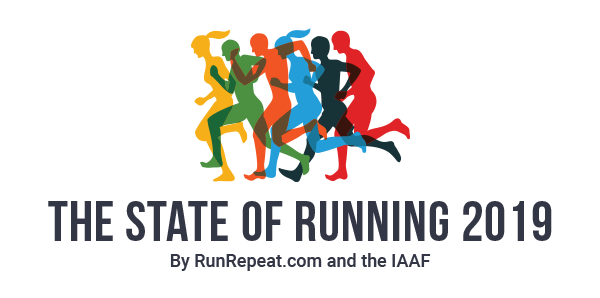
Key conclusions
- Event participation has declined by 13% since 2016, when it peaked with 9.1 million runners crossing the finish line. Growth continues in Asia.
- Runners have never been slower - male runners in particular. In 1986 the average finish time was 3:52:35, whereas today it's 4:32:49 - a slowdown of 40 minutes and 14 seconds.
- Runners have never been older ageing from 35.2 in 1986 to 39.3 in 2018.
- Spain has the fastest recreational runners on the marathon distance, Russia on the half marathon, Switzerland on the 10K and Ukraine on the 5K.
- For the first time in history, there are more female than male runners. In 2018, 50.24% of runners were female.
- Travelling to race has never been more popular than today.
- The motives for participating in running are potentially changing from being acheivement-focused to being phycological, health and socially focused, which in part can be proved by more people travelling to race, slower finish times and how milestone-ages (30, 40, 50) now are much less dominant than 15 and 30 years ago.
If you're looking to compare yourself to other runners, check out our finish time comparison tool.
Data and methodology
- The data covers 96% of US race results, 91% of the race results from the EU, Canada, and Australia and a big portion from Asian, Africa and South America.
- Elite runners have been excluded and thus this is an analysis of recreational runners.
- Walks and "walk/run for charity" events have been excluded as well as obstacle course races and other non-traditional running events.
- Parkrun 5K data was not included as the timing on these races is started for the entire group and not as individuals cross a dedicated start line.
- All 193 UN-recognised nations are included.
- The study was done in collaboration with the International Association of Athletics Federations (IAAF) and presented in China in June 2019.
- Data collection was done through databases of race results as well as individual Athletics Federations and races sharing race results.
- 107.9 million race results, 70,000 events
- From 1986 to 2018
The trends of mass participation running
Global race participation in decline
Running is huge and has a big following, but as we can see from the chart below it's declining in the last two years. This is mainly due to a decline in participation in Europe and the US. Participation in Asia is very much on the rise, just not enough to compensate.
The participation in running races has peaked in 2016 with a total of 9.1 million results and then it declined to 7.9 million (a decline of 13%) in 2018. If we look at the change in participation in the last 10 years there is an increase in participation of 57.8% (from 5 to 7.9 million participants).
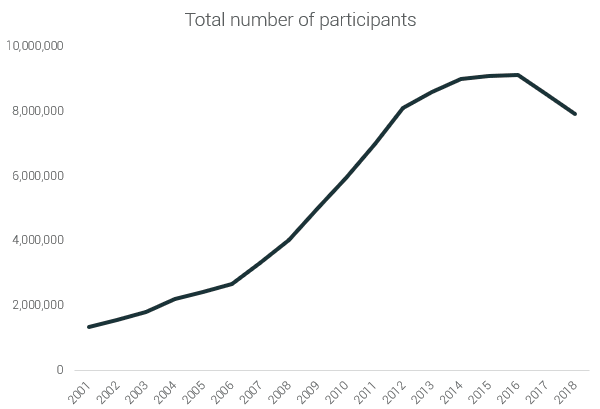
5-kilometre races and half marathons have the highest numbers of participants (2.9 and 2.1 million participants in 2018, respectively). But also have suffered the biggest decline in participation in the last 2 years. Half marathoners have declined by 25% (from 2.9 million) in the last 2 years. and 5K participants have declined by 13% (from 3.4 million).
10Ks and Marathons have a more modest following - 1.8 and 1.1 million participants respectively in 2018. But it's quite stable over the last few years - the participation rates have fluctuated less than 2% the last 2-3 years.
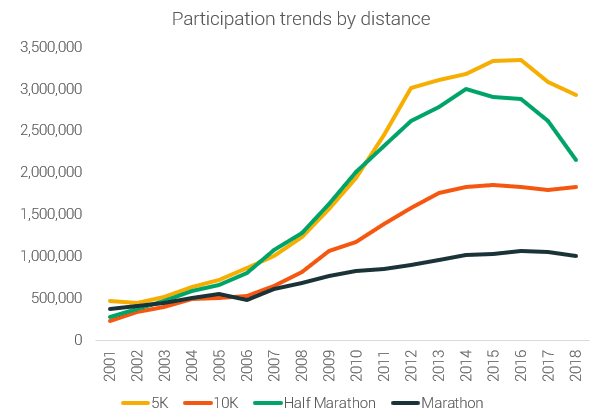
While we do not have the answer to the decline, a few hypotheses are:
- Running has grown by 57% over the past 10 years, which is great, but any sport, as it attracts the masses, will have a period of decline. We cannot say if this is a short-term trend or a long term one. Of course, the industry should be alert.
- As something becomes very popular, other niches within that sport will rise. That's the case with running. In everything we do, we humans do in part to associate ourselves with others. Are you a runner? 10 years ago, running a marathon was the ultimate goal for many athletes. Not many did it. It attracted a certain audience. Then a group of less experienced athletes joined the pack and proved that they could do it as well. The trend kept going, and at some point, the the extreme athletes did not find the marathon extreme anymore. They did not feel special, which was an important element of running the marathon. Because of this, the ultramarathon, trail running, the Ironman and so on exploded in popularity.
- The motives for running are potentially changing, and the races have not picked up on this trend. There are quite a few indicators of this. In our report, we prove how 1) running at milestone ages (30, 40, 50, 60) is significantly less important in 2019 than it was 15 years ago, 2) people travel more than ever to race and 3) the finish times are slower. With people being slower, it's not the individual who's getting slower, but the average of all runners, meaning that the "demography" has changed. More slow runners participate. These three indicate a growth in the experience economy rather than achievement-motives. This is very important, we think, and we think that the industry hasn't been good enough at adjusting their races.
It's also interesting to see which do people prefer - smaller or bigger races. We have chosen 5,000 participants as the boundary.
Our analysis shows that almost equal amounts of people enter small races as do big races, with a slight preference for the bigger ones. On average big races attract 14% more participants.
Also, the participation trends for both types of races follow a similar trend. The participation in big races is on the rise until 2015 and for small races, it's on the rise until 2016. But the decline in participation in the smaller races is more pronounced - 13%, compared to the one for the bigger races - 9%.
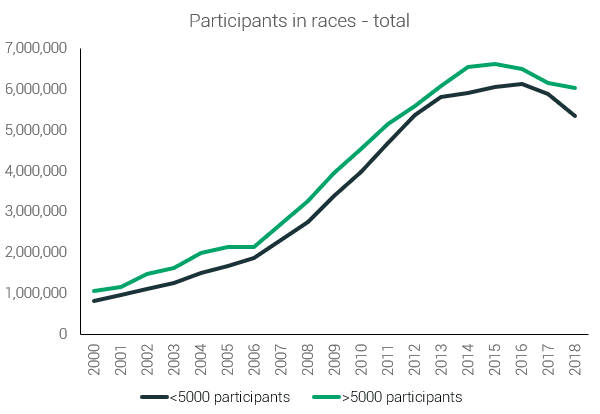
When we talk about running races we usually think about marathons, however, in the last few years, they account for just 12% of the results (shrunk from over 25% at the beginning of the century). This has led to growth in half marathon participation, an increase from 17% to 30% of total participants
The proportions of participants in 5Ks and 10Ks are quite stable, but still experiencing some growth - 5K participants have increased by 3% on average, and 10K participants by 5%.
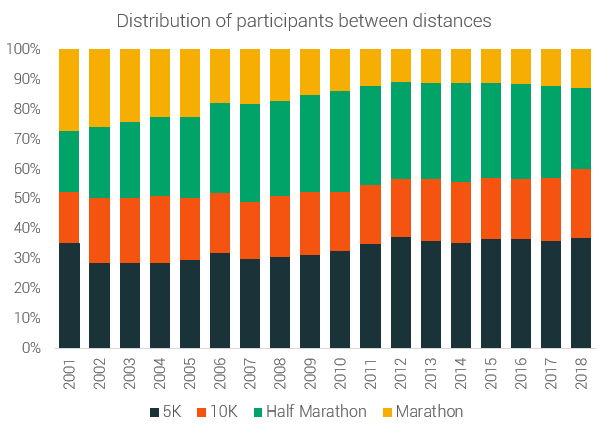
Trends in finish times
Marathon finish time trends
The world is getting slower. But runners are slowing down much less since 2001. The marathon finish time had increased by 36 minutes - from 3:52:35 to 4:28:56 (an increase of 15.6%) in the period between 1986 and 2001. And since 2001 it has increased by just 4 minutes to 4:32:49 (an increase of 1.4%).
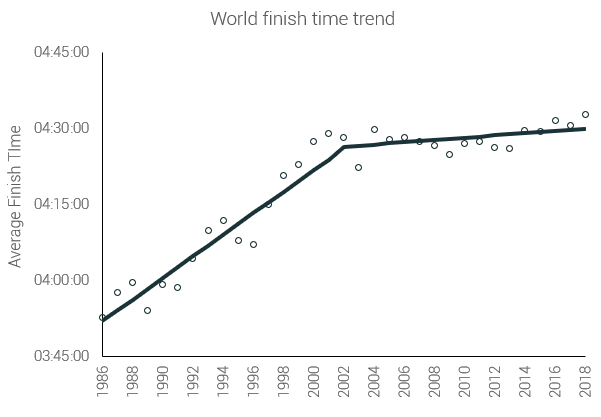
When we look and the finish time trends by gender we see that men are continuously slowing down, even though to a smaller degree after 2001. Men finish time had increased by 27 minutes - from 3:48:15 to 4:15:13 (an increase of 10.8%) by 2001 and after that, it has increased on average by 7 minutes (an increase of 3%).
On the other hand, women were slowing down faster than men - from an average time of 4:18:00 in 1986 to an average of 04:56:18 in the year 2001 - a difference of 38 minutes (14.8%), but after that have actually become faster. Women's finish times have declined on average by 4 minutes (a decrease of 1.3%).
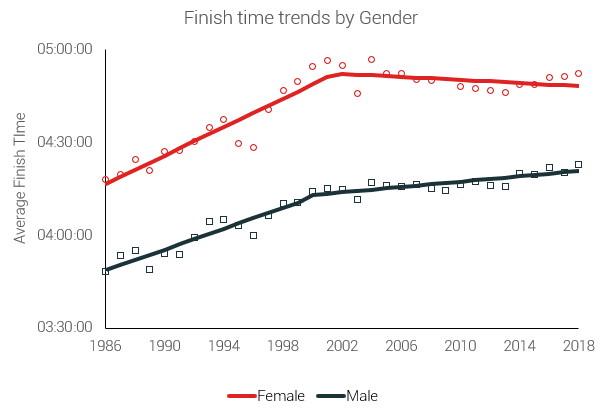
Finish time trends by distance
For all other distances, we see a stready increase in finish times for both men and women, and only for the marathons, we can see that this trend is tapering off.

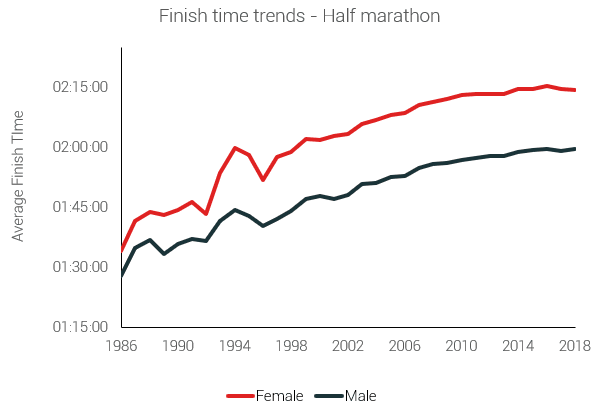
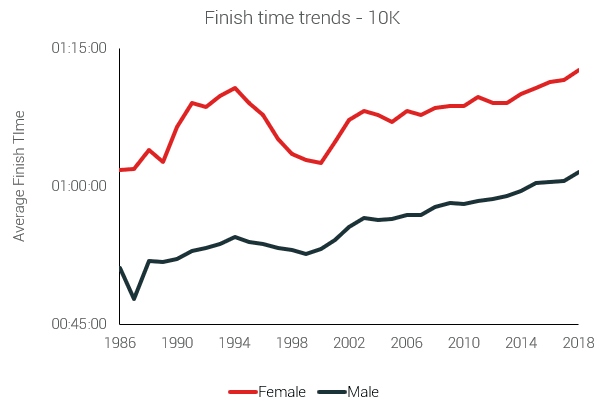
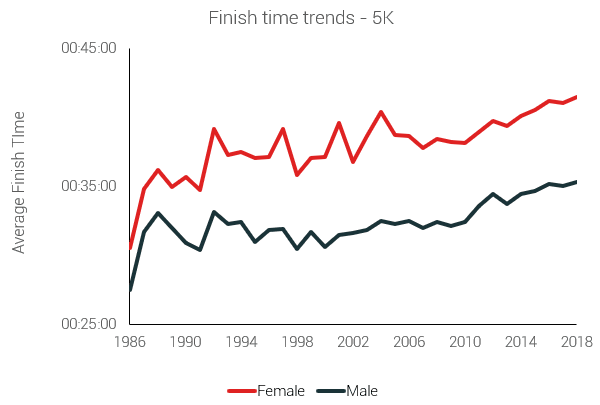
Pace comparison by distance
When we look at the average pace for the 4 distances we see that runners from both sexes perform best at half marathons - at all ages. Their pace at this distance is significantly smaller than the pace for the other distances.
The average pace of male half marathoners is 5:40 minutes per kilometre and for female half marathoners, it is 6:22 minutes per kilometre.
The average male pace for marathons is 6:43 (18% slower than for half marathon), and the average female pace is 7:26 (17% slower than for half marathon).
The average male pace for 10Ks is 5:51 (3% slower than for half marathon), and the average female pace is 6:58 (9% slower than for half marathon).
The average male pace for 5Ks is 7:04 (25% slower than for half marathon), and the average female pace is 8:18 (30% slower than for half marathon).
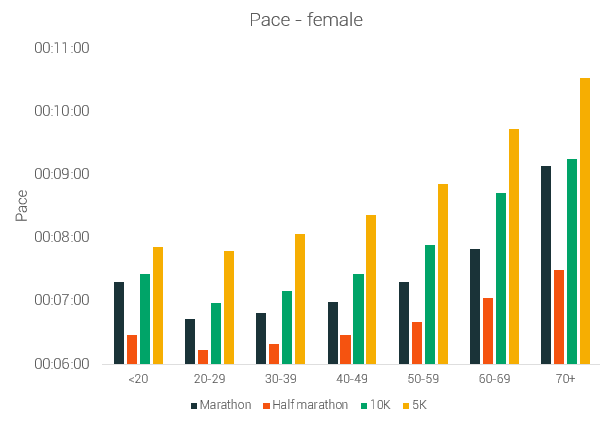

This could be due to the increased proportion of participants in half marathons - it is possible a lot of the good marathon runners to be switching to half marathons, or maybe adding half marathons to their repertoire.
Also, the slowest average pace corresponds to 5Ks, because this is the entry distance for almost all runners who race. This means that this is the distance with most novices.
Finish times per country
The United States is the country with the biggest number of race runners but from the countries with most participants, it's the slowest. And consistently.
On the other hand, after the year 2002, Spain has consistently been the fastest marathon nation.

Click the accordions below to see who's faster and slower on each of the distances.
Fastest 5K nations
It's quite surprising that Spain is the fastest marathon nation, but it's among the slowest nations in 5Ks. For 5Ks, the fastest nations are Ukraine, Hungary, and Switzerland. Switzerland is number 3 for 5Ks, number 1 for 10Ks and number 2 in marathons, which places the Swiss among the best runners in the world.
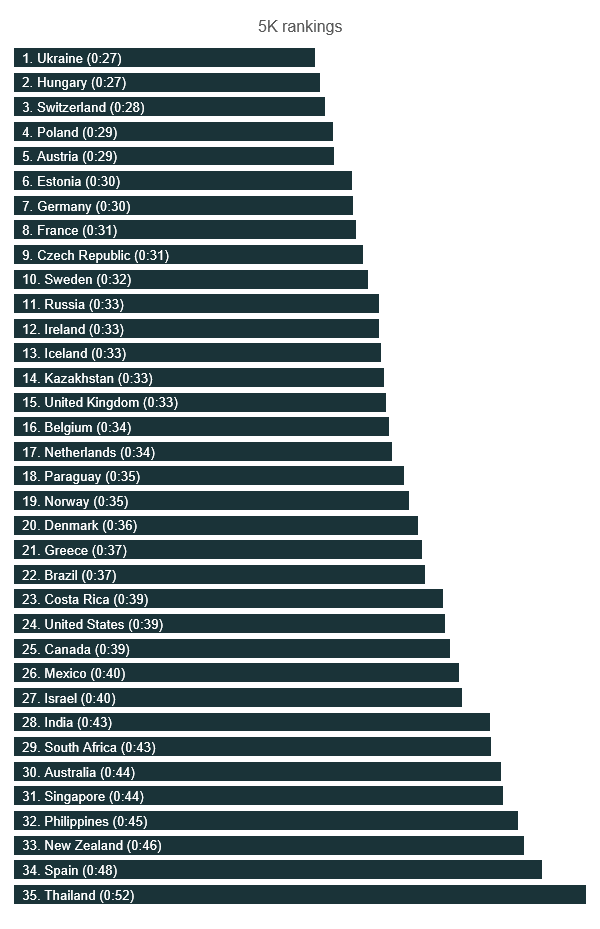
When we look at the separate rankings for men and women we see, that Spanish men are among the fastest 5K runners, but they are just a small proportion of the Spanish 5K participants. The nations with the fastest men at this distance are Ukrainians (average finish time of 25 minutes 8 seconds), Spaniards (25 minutes 9 seconds) and the Swiss (25 minutes 13 seconds).
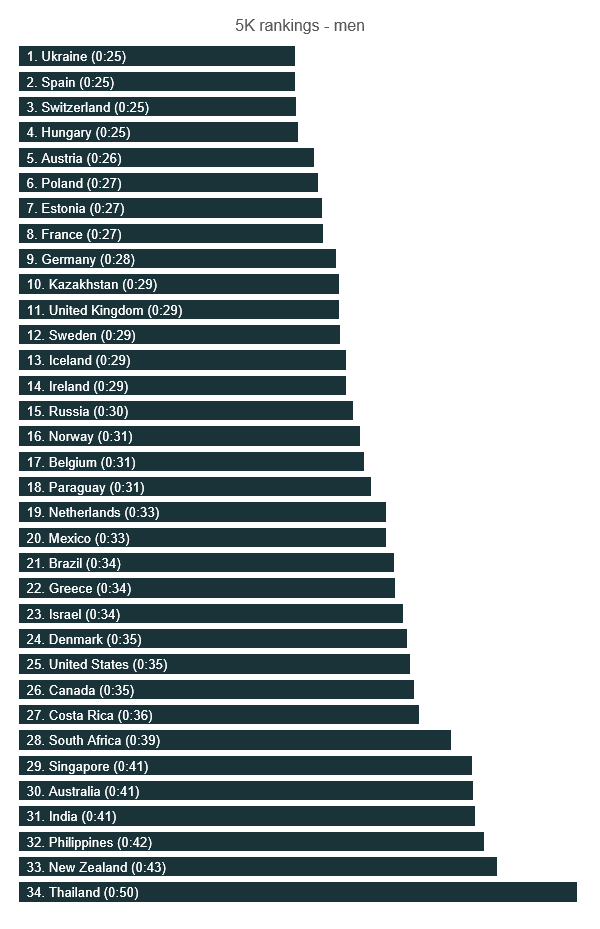
The slowest men are from the Philippines (42 minutes 15 seconds), New Zealand (43 minutes 29 seconds), and Thailand (50 minutes 46 seconds).
The fastest women at 5Ks are Ukrainians (29 minutes 26 seconds), Hungarians (29 minutes 28 seconds) and Austrians (31 minutes 8 seconds). Ukrainian women are faster than the men of 19 of the 34 countries in our ranking.

Here we see that Spanish women are the second slowest 5K runners in the world, next to the women from the Philippines and Thailand.
Some of these nations have improved over the years and some of them have slowed down. Bellow, we can see the change in the finish times over the last 10 years. Even though Philippinos are among the slowest runners, they are among the most improved.
The most improved are the Irish - they have lost almost 6 minutes of their average finish time. On the other hand, the Spanish have added almost 5 minutes to their average, which is the biggest slow-down.
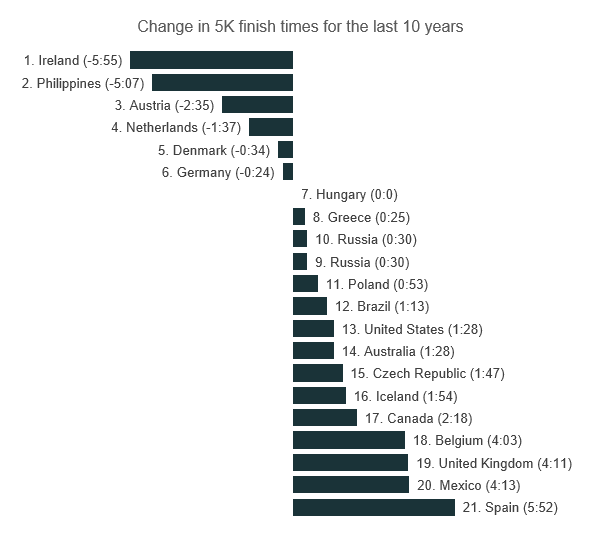
Fastest 10K nations
The Swiss tops the chart for 10Ks with an average finish time of 52 minutes 42 seconds. Luxemburg is in 2nd place (53 minutes 6 seconds). Portugal is also performing very well in 10Ks (53 minutes 43 seconds) and marathons, taking the 3rd place in both distances.
On the slow end of the spectrum, Thailand and Vietnam are among the slowest nations in 3 out of the 4 distances.
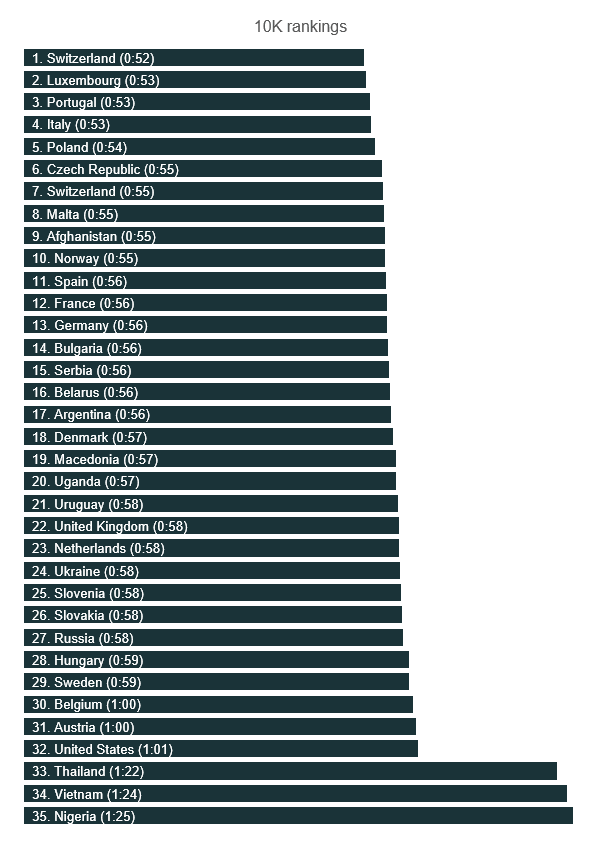
When we look at male rankings, the Swiss are still number one (48 minutes 23 seconds) and the men from Luxembourg are second (49 minutes 58 seconds), but here the Norwegians are in the third place with an average time of 50 minutes 1 second.
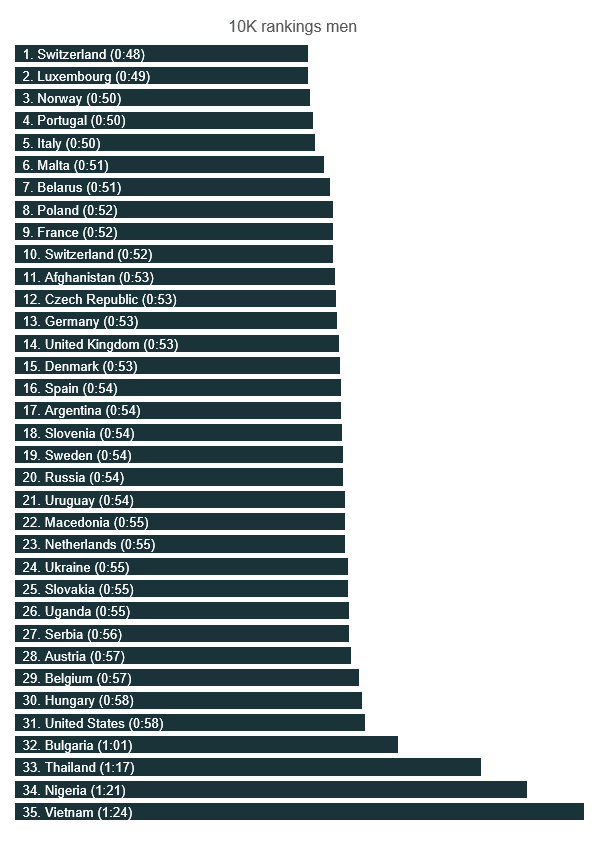
Portuguese women are first in 10Ks (55 minutes 40 seconds). They are faster than the men from Vietnam, Nigeria, Thailand, Bulgaria, Greece, Hungary Belgium, Austria, and Serbia.
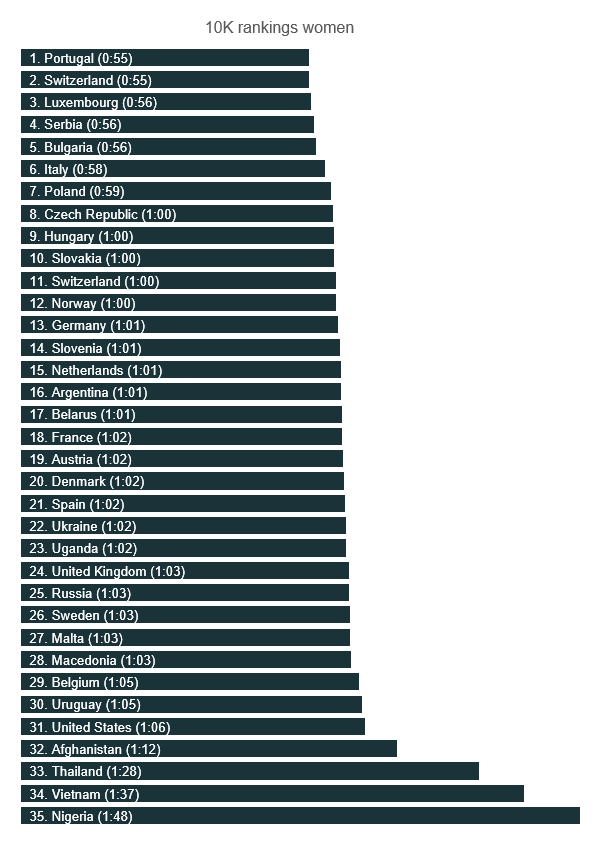
Just 5 nations have improved at 10Ks, with the most improved being our 5K winners - Ukraine. They have improved by the impressive 12 minutes 36 seconds. The Italians are the ones who have added most to their average finish time - they have slowed down by 9 and a half minutes.
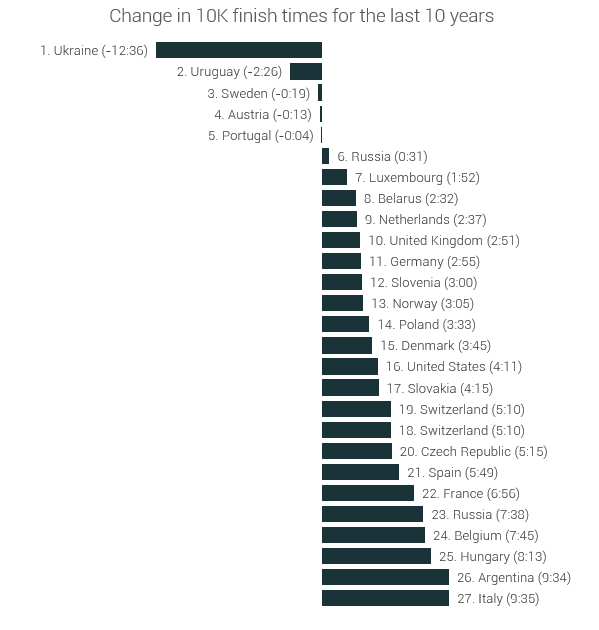
Fastest half marathon nations
Russia tops the chart for half marathons (1 hour 45 minutes 11 seconds), Belgium is second (1 hour 48 minutes 1 second) and Spain is 3rd (1 hour 50 minutes 20 seconds). It's no surprise that European countries make the top 3 in this distance, given that the half marathon is the preferred distance of Europe. On the slow side, Malaysia is the slowest in half marathons and marathons. Malaysians are 33% slower than the Russians.
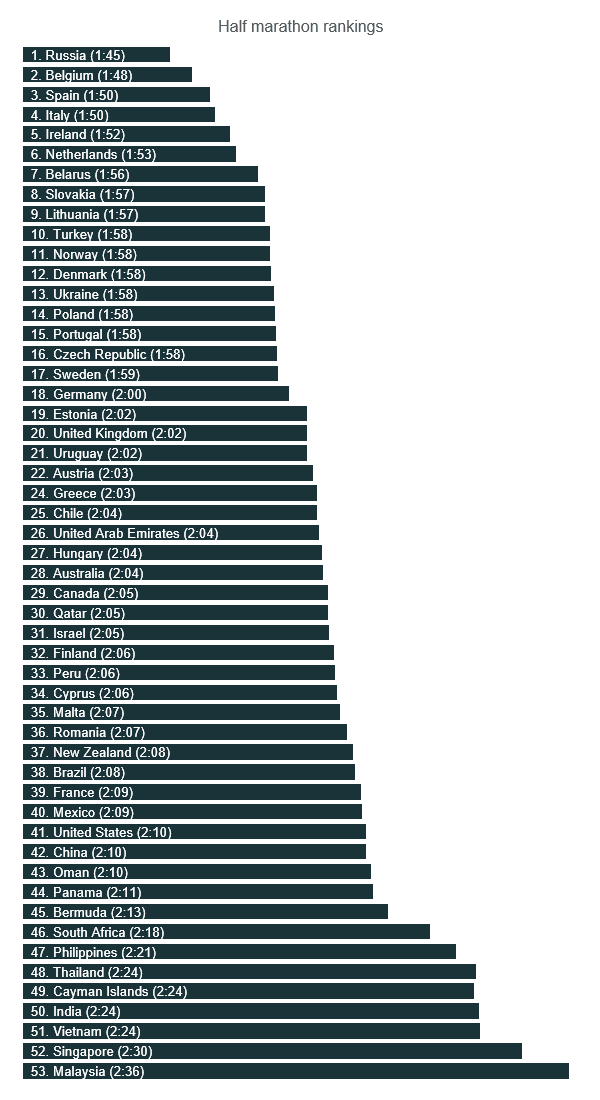
Russia tops both the male and the female rankings at half marathons and Belgium is second.
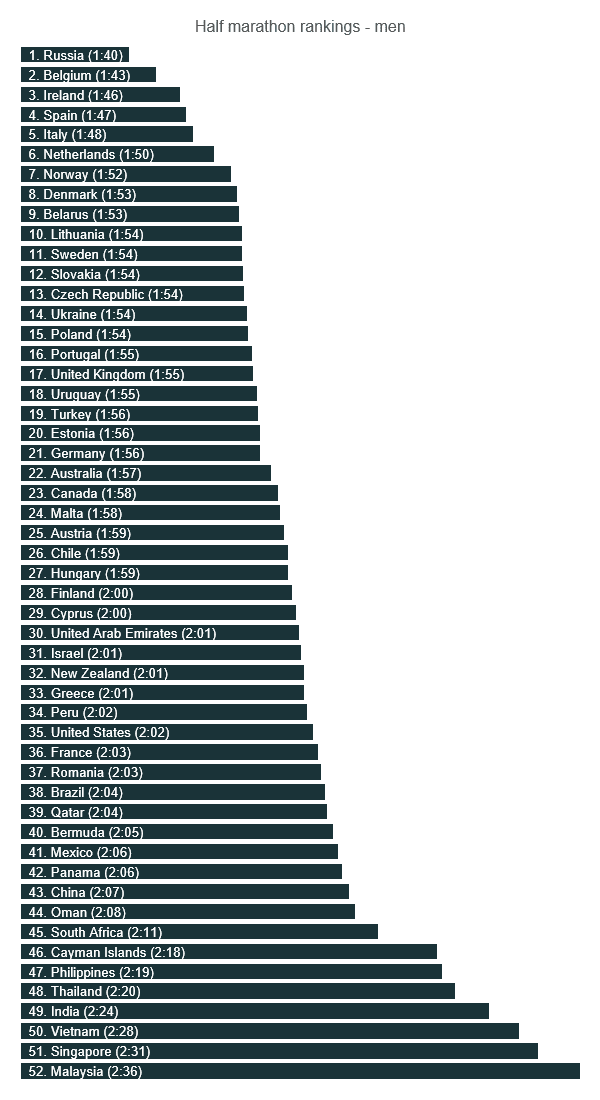
Russian women are faster than the men from 48 out of the 53 countries in the rankings, which is impressive.
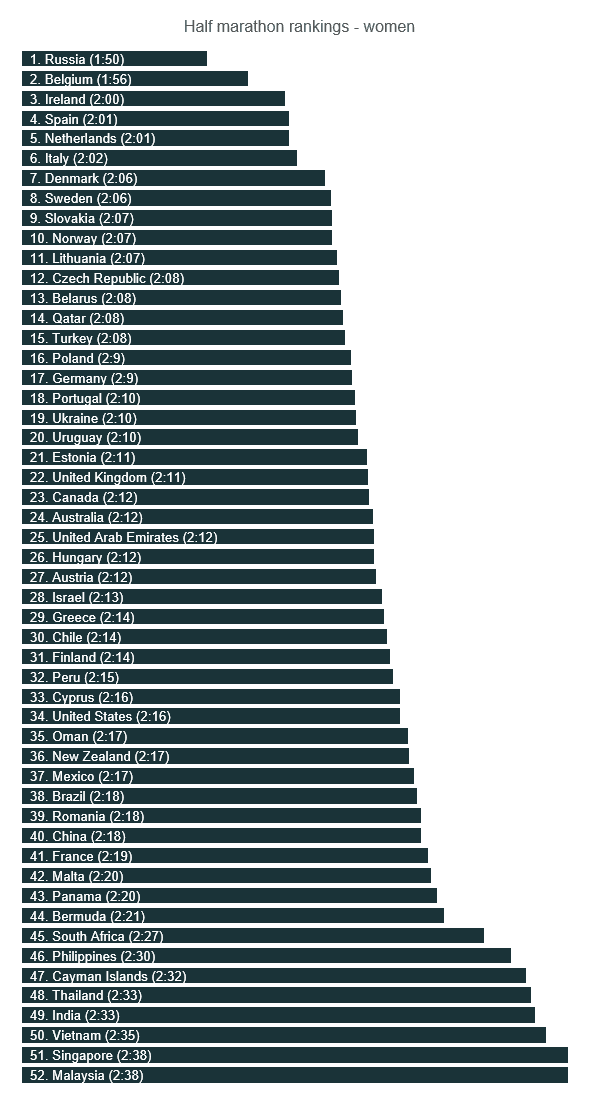
As with 10Ks, only 5 nations have improved over the last 10 years. The most improved is #1 - Russia. They have shaved off almost 14 minutes of their average finish time. And the second most improved is the second-ranking nation - Belgium. Their improvement is more modest but still impressive - their average finish time has declined by 7 and a half minutes.
Surprisingly the most slowed-down nations are Scandinavian - Denmark and the Netherlands. But they still rank very well overall at places #6 and #8.

Fastest marathon nations
The top 3 marathon nations are Spain (3 hours 53 minutes 59 seconds), Switzerland (3 hours 55 minutes 12 seconds), and Portugal (3 hours 59 minutes 31 seconds).
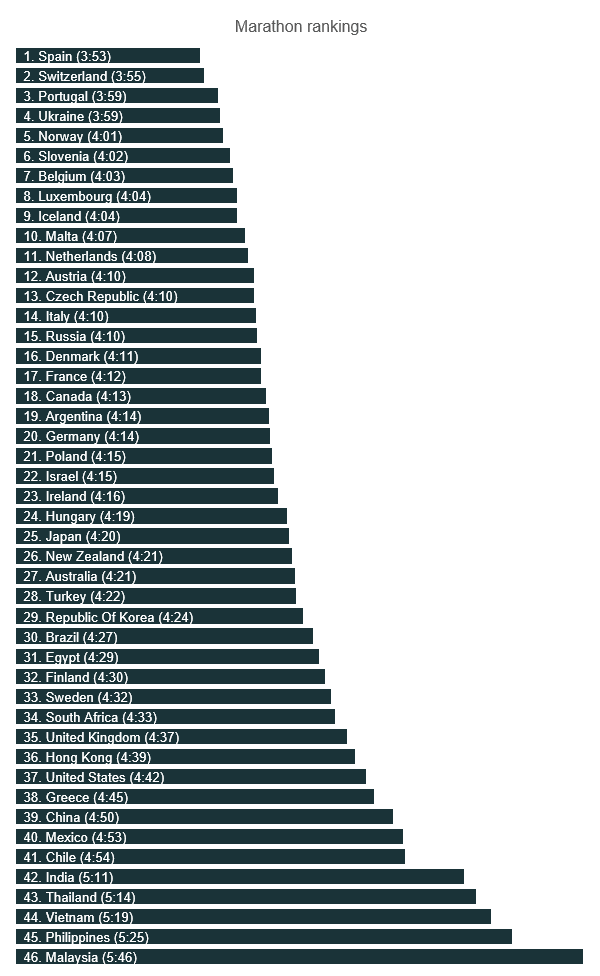
The top 3 fastest men are from Spain (3 hours 49 minutes 21 seconds), Portugal (3 hours 55 minutes 10 seconds) and Norway (3 hours 55 minutes 14 seconds).
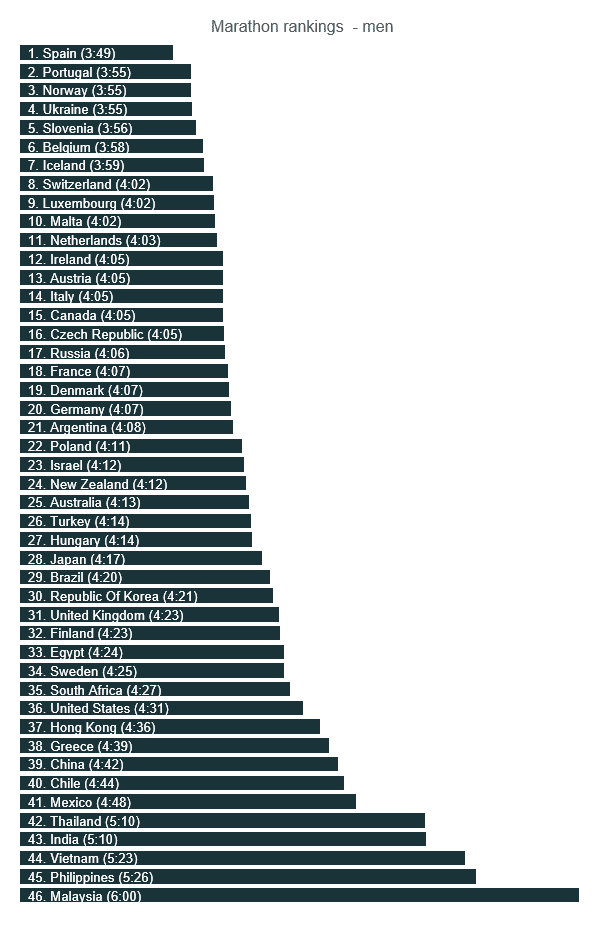
The top 3 for women is completely different from the top 3 for men. The fastest women are from Switzerland (4 hours 4 minutes 31 seconds), Iceland (4 hours 13 minutes 51 seconds) and Ukraine (4 hours 14 minutes 10 seconds.
Swiss women are 9 minutes 20 seconds faster than the runner ups - women from Iceland. Also, Swiss women are faster than men from 63% of the countries we've analysed.
Their average finish time is faster than the finish times of the men from United States, Japan, South Africa, United Kingdom, Singapore, Vietnam, Philippines, Russia, India, China, Mexico and many more.
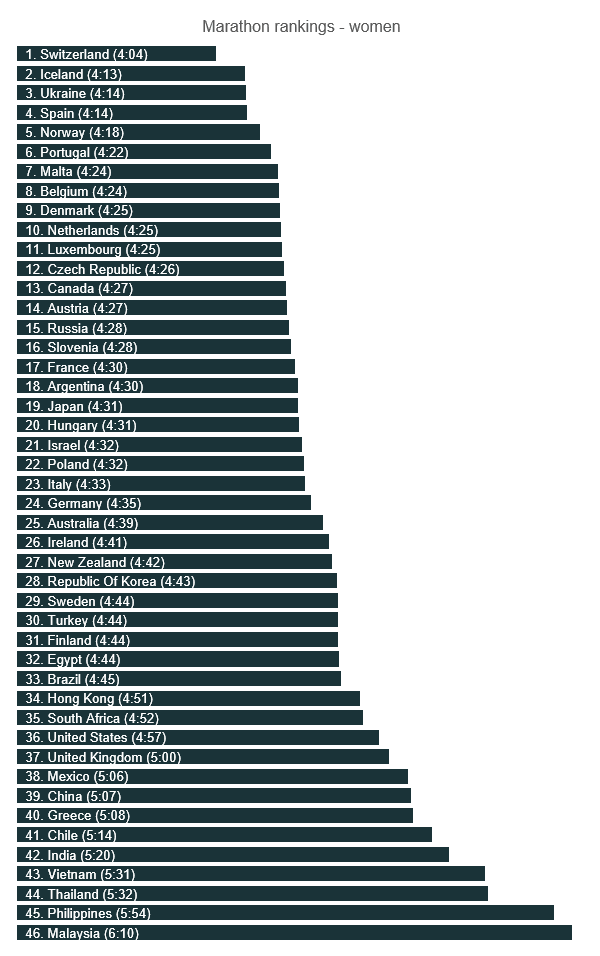
Most of the nations have slowed down over the last 10 years. The biggest slow-down belongs to Vietnam - they have added almost an hour to their average finish time. The most improved are the Ukrainians - by 28 and a half minutes. Among the improved nations there is just one non-European nation, and this is Japan. They have shaved off more than 10 minutes from their average time.
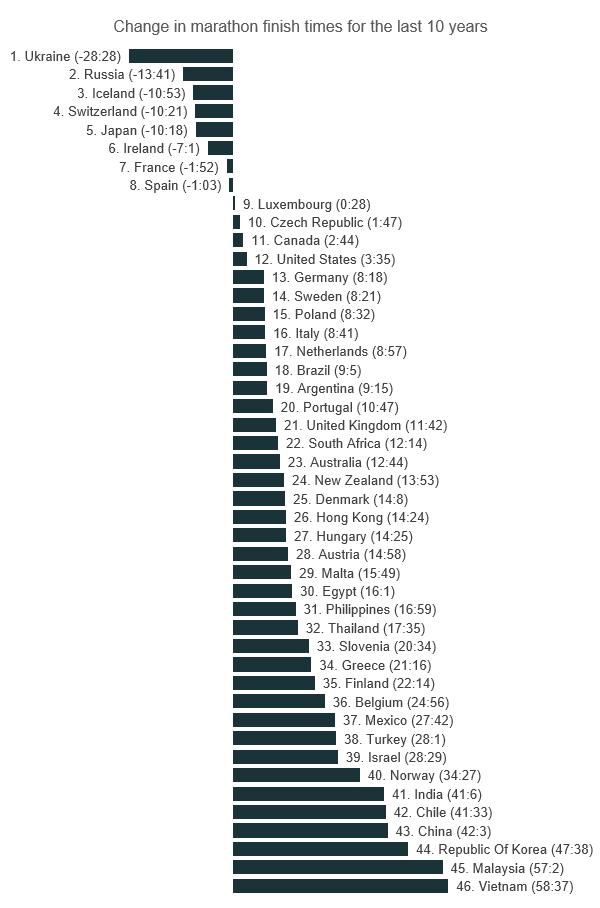
Age trends
Runners have never been older
Runners on average are getting older - the average age of runners in 1986 was 35.2 and in 2018 it is 39.3. This could be due to the fact, that runners have longer racing careers, and also that people are welcome to start racing at an older age. We can see that in the sharp increase in the average age of 5K participant over the last 7 years.
The average age of 5K runners has increased from 32 to 40 (25%), for 10Ks it has changed from 33 to 39 (23%), for half marathons - from 37.5 to 39 (3%) and for marathons - from 38 to 40 (6%).
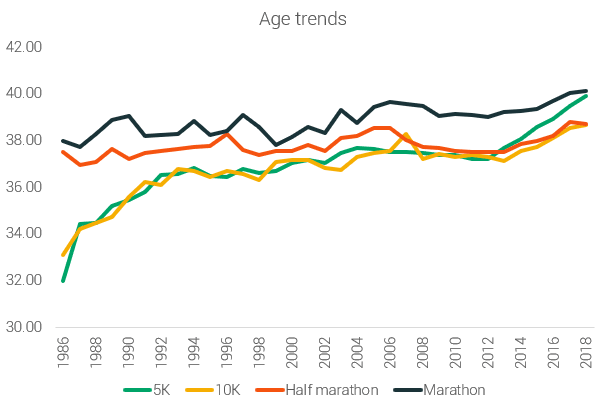
Finish time by age group
It is not surprising that the participants over 70 are consistently the slowest ones (average finish time in 2018 - 5 hours 40 minutes), but younger isn't always better.
The participants in the 30-50 bracket perform best (average finish time 4 hours 24 minutes). The participants under 30 are comparable with the participants between 50 and 60. The average finish time for the participants under 30 is 4:32 minutes and for the 50 to 60 year-olds it's 4 hours 34 minutes.

This could be due to lack of experience or training, or maybe because a lot of young participants are just "trying" marathon running and are participating mostly for social benefits.
Age distribution
For marathons, there is an increase in participation of the youngest participants (from 1.5% to 7.8%), but also a decline in participation of 20-30-year-olds (from 23.2% to 15.4%). It's noteworthy that 40-50-year-olds participation is on the rise (from 24.7% to 28.6%), which is consistent with people having longer racing careers.
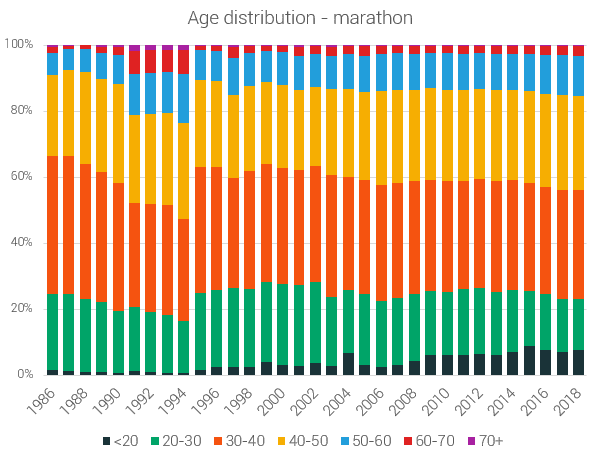
For 5K's we see that the younger participants are in decline, but more and more participants over 40 are joining in. This is consistent with the fact that nowadays people are free and welcome to start racing at an older age.
The proportion of participants bellow 20 in the 5Ks hasn't changed much, but the proportion of 20-30-year-olds has declined from 26.8% to 18.7%. Also, the proportion of 30 to 40 year-olds is shrinking - from 41.6% to 32.9%. The proportion of participants over 40 has grown from 26.3% to 50.4%
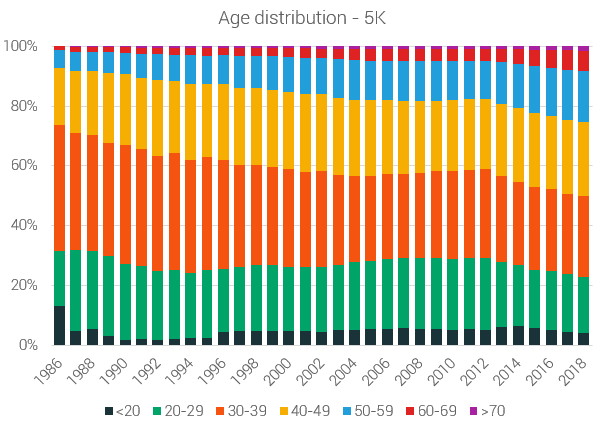
Running a marathon is still a great achievement, but it used to mark milestone ages much more than it does today. In 2018 there are still spikes at the ages ending in 5, but they are much smaller than 15 or 30 years ago.

Age distribution by gender
For women, the distribution of participants is left-skewed and the median age of participants is 36. Women, in general, start and stop racing at a younger age. This is considered to be so because of childbirth and the still bigger obligations of women in child rearing.

Men's participation peaks around 40 and is much closer to normal than it is for women.
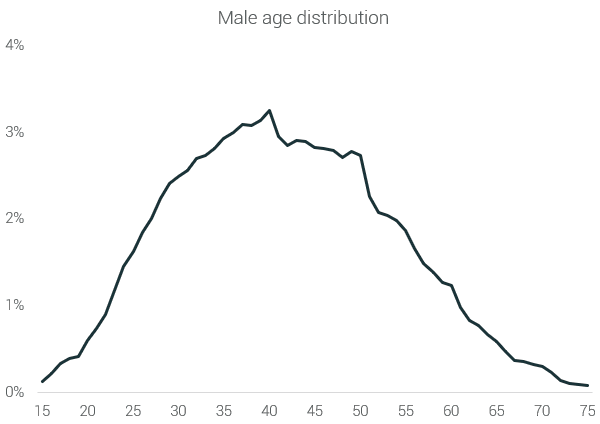
Women in running
More female than male runners for the first time in history
Running is among the sports that are most open to women. In 5Ks close to 60% of the participants are women, nowadays.
In total female participation has risen from under 20% in 1986 to just above 50% in 2018.
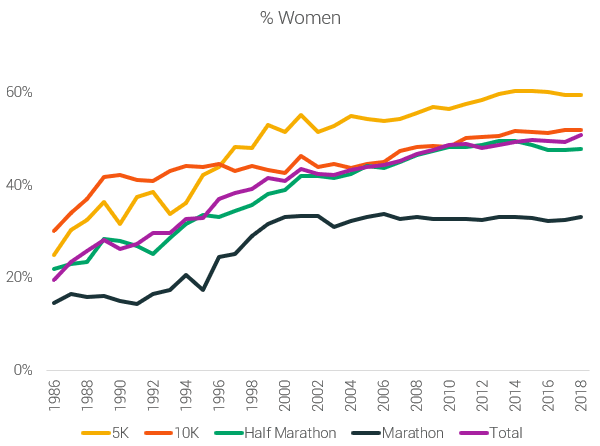
Countries with the highest and lowest female participation
The countries with the highest proportions of female participants are also the ones that have the most gender equality. Here we see Iceland, the US, and Canada taking the lead. It is quite surprising though to see that Switzerland and Italy are among the countries with the least female participation.
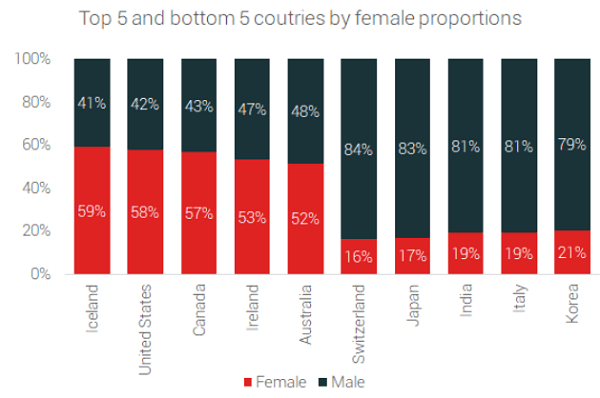
How countries race differently
Distribution of participants by distance
The top 3 nations with most marathon runners are Germany, Spain, and the Netherlands. France and the Czech Republic have the biggest proportions of half-marathoners. Norway and Denmark have the most 10K runners. And in the US, Philippines, and South Africa, 5Ks are the most popular.
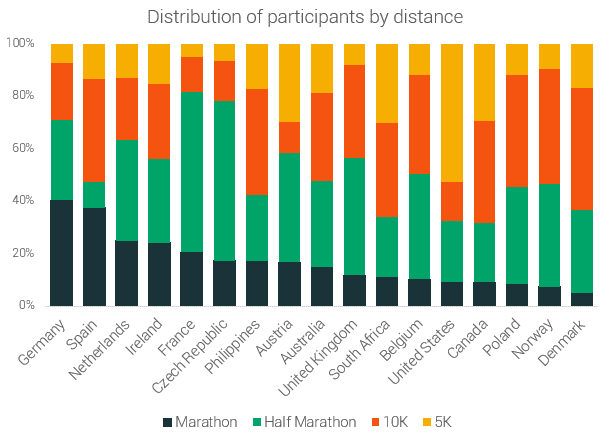
When we look at the distribution of participants by continent, we see that North America is the continent of 5Ks, Asia's preferred distance is 10K, and Europe's - half marathons.
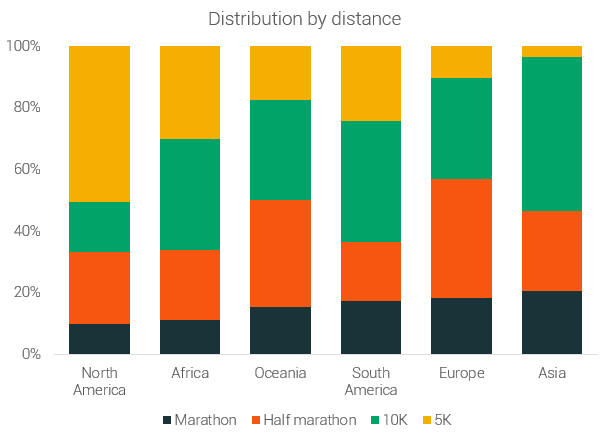
Climate and running
Based on our previous research we see that temperature has a huge impact on finish times, with the optimal running temperature being between 40 and 50 degrees (F).

For this reason, climate affects how people race - with most participants racing in countries with temperate and polar climates.
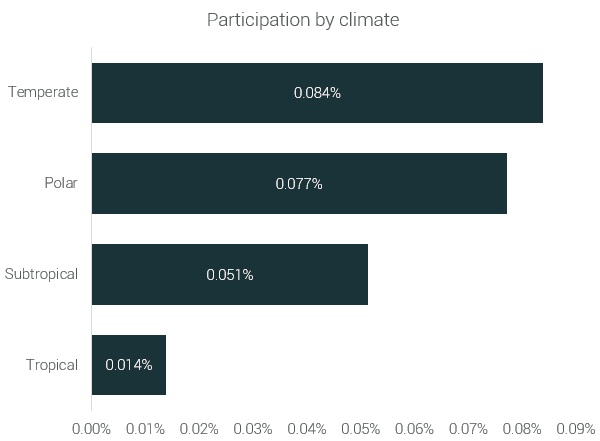
Travelling trends
Travelling to race has never been more popular
More and more people travel to run in a race. The percentage of people travelling to a different country for a race has increased significantly.
For marathons, it has increased from 0.2% to 3.5%. For half marathons - from 0.1% to 1.9%. For 10Ks - from 0.2% to 1.4%. For 5K this percentage has actually decreased from 0.7% to 0.2%, which could be due to the increase in the number of events available.
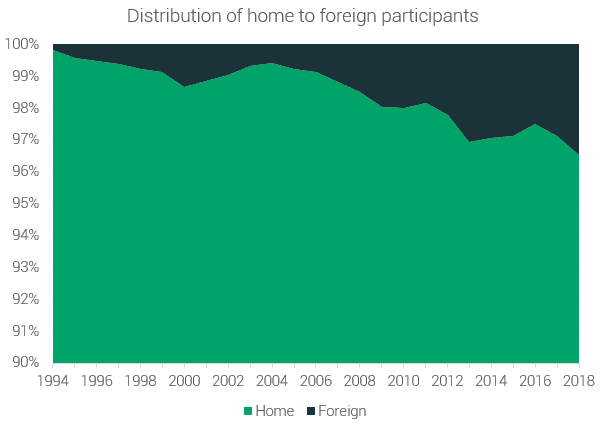
One of the reasons for this change is that the world is getting smaller. First, more and more people speak English, especially at races and also now, there are a lot of the translation apps that make communication easy. As we can see the proportion of people travelling from English speaking countries to not English people speaking countries has increased the most in the last 20 years - from just 10.3% to 28.8%.
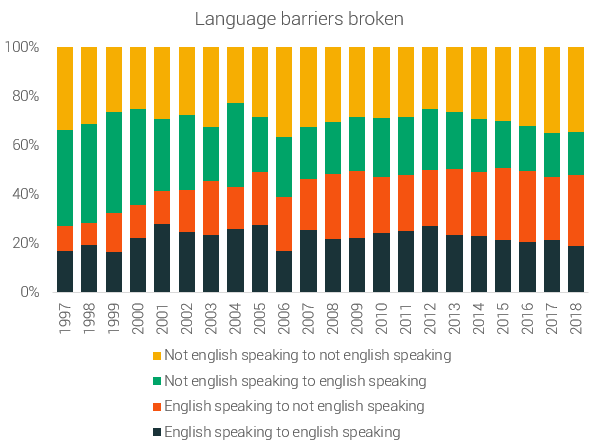
Comparison between home and foreign participants
In general, foreign participants are faster than home participants, but the gap is closing in.
In 1988 foreign female participants had an average finish time of 3 hours 56 minutes, which is 7% faster than home female participants (average finish time - 4 hours 13 minutes), in 2018 this difference is just 2%. Home participants had an average finish time 4 hours 51 minutes, and foreign participants had an average finish time of 4 hours 46 minutes.
For male participants - foreign participants were 8% faster. Home participants' time was 3 hours 45 minutes, and the average foreign finish time was 3 hours 29 minutes in 1988. In 2018, the average finish time for home male participants was 4 hours 21 minutes and foreign participants had an average finish time of 4 hours 11 minute, which is 4% faster.
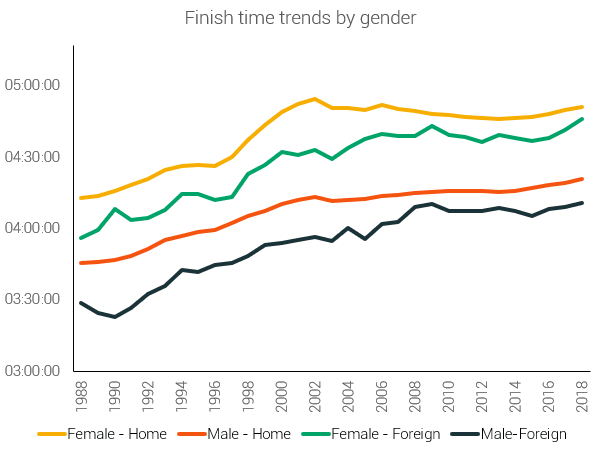
Also, people who travel for a race are older in general - on average by 4.4 years.
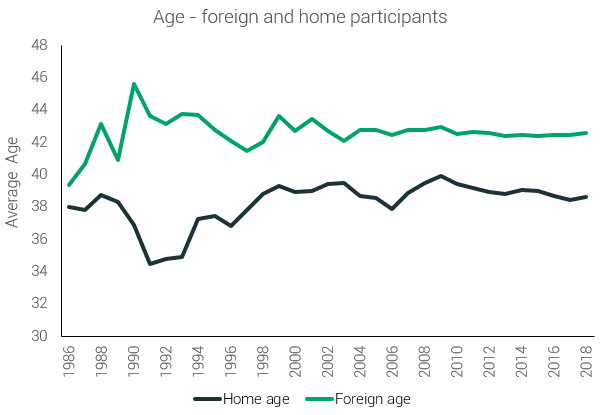
Country profile of travellers
Most people travel to mid-size countries. This could be due to the fact that there are plenty of races in countries of this size, and also that travel is convenient.
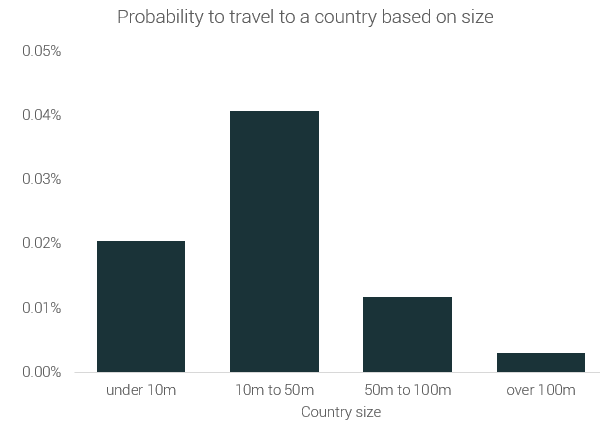
The people who travel most are to a large degree from small countries. Maybe this is due to the fact that there are much fewer events there.
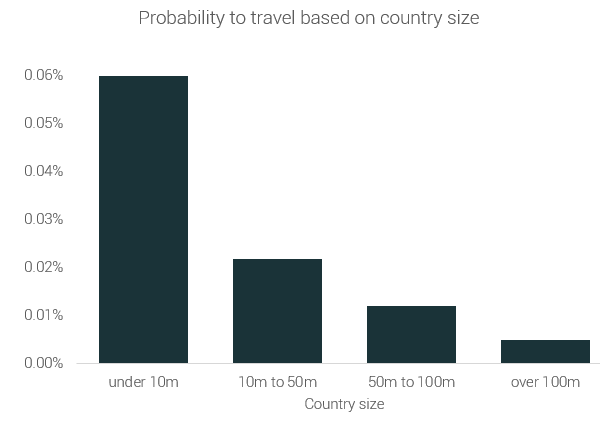
Motives for running are changing
There are 4 categories of motives to run
1. Psychological motives
- Maintaining or enhancing self-esteem,
- Life meaning
- Coping with negative emotions
2. Social motives
- Affiliate oneself with others
- Recognition and approval
3. Physical motives
- Health
- Weight loss
4. Achievement motives
- Competition
- Personal goals
From competition to experience
There are a few signs that the reasoning behind running in a race is changing:
- Slower finish times
- More travellers
- Less milestone-age runners
This could be explained by people nowadays focussing more on psychological motives rather than achievement motives.
But, it could also be that the sport is more accessible by the average athlete, who has other motivations. This means that motivations haven’t changed, but the sport has attracted another group of runners, that have other motivations, which change the average finish time, percentage of travellers and percentage of people running milestone-age races.
Maybe, the achievement motivated runners have transitioned to ultra running. Maybe the average runner today is more focused on a good experience than an achievement than before - not saying it’s overshadowing the achievement motive, but saying that maybe achievement means less today, relatively to the experience itself.
Running fast requires good running shoes
If you want to improve your finish times, consider buying a pair of lightweight running shoes. The lighter the shoes, the faster you run (to a certain limit). Beware that you'll also have less cushioning though. Here's an overview of all our running shoe reviews where you can set tens of filters to find the best pair for you, as well as more running statistics for 2021.
Most people stick to Nike running shoes, ASICS, Adidas or Brooks, but you should also consider more niche road running brands like On running shoes or Hoka running shoes, particularly famous in the trail running community.
Finally, we also review trainers and all other types of sports shoes. Within our sneaker category, we have two types of trainers. High fashion brands like Balenciaga trainers, but also the more general brands like Nike trainers, Adidas trainers and the likes that are known for their athleisure style.
